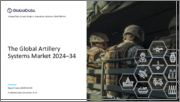
|
시장보고서
상품코드
1570909
포병 시스템 시장, 기회, 성장 촉진요인, 산업 동향 분석과 예측(2024-2032년)Artillery Systems Market, Opportunity, Growth Drivers, Industry Trend Analysis and Forecast, 2024-2032 |
||||||
세계의 포병 시스템 시장은 2023년에 121억 3,000만 달러로 평가되며, 2024-2032년 CAGR은 8%를 넘을 것으로 예측됩니다.
몇 가지 주요 동향이 업계의 성장 궤도를 형성하고 있습니다. 가장 두드러진 추세는 정밀유도탄(PGM)과 첨단 포병 시스템에 대한 수요가 급증하고 있다는 점입니다. 오늘날의 포병 플랫폼은 GPS 및 레이저 유도탄과 같은 고급 유도 시스템을 장착하고 있습니다. 이러한 강화는 정확도를 높일 뿐만 아니라 부수적 피해를 크게 줄일 수 있습니다. 이러한 진화를 추진하는 배경에는 민간인 희생을 최소화하고, 작전 효과를 강화하며, 정확한 정확도로 전략적 목표를 달성하는 데 초점을 맞추는 데 대한 관심이 높아지고 있습니다.
포병 시스템 산업은 유형, 컴포넌트, 구경, 거리, 지역별로 분류됩니다.
유형별 시장 세분화에는 곡사포, 박격포, 로켓포, 해안 및 해군 대포, 대공 시스템 등이 포함됩니다. 특히 대공 분야는 예측 기간 중 10% 이상의 CAGR을 나타낼 것으로 예상됩니다. 이러한 특수 시스템은 고정익 항공기 및 헬리콥터에서 무인 항공기(UAV)에 이르기까지 공중에서 발생하는 위협에 대응하기 위해 설계되었습니다. 이러한 시스템은 가벼운 대공포에서 레이더 유도 조준 및 사격 통제 기능을 갖춘 첨단 지대공 미사일(SAM) 시스템에 이르기까지 다양한 범위에 걸쳐 있습니다.
구경을 기준으로 세분화하면 시장은 소형(105mm 미만), 중형(105mm-155mm), 대형(155mm 이상) 카테고리로 나뉩니다. 전 세계를 휩쓸고 있는 중 구경 부문(105mm-155mm)는 2032년까지 100억 달러 이상의 매출을 기록할 것으로 예상됩니다. 곡사포와 화포를 포함한 중 구경 포병 시스템은 전 세계에서 정규 전력의 중추적인 역할을 하고 있습니다. 기동성과 화력의 균형을 유지하면서 장거리 표적에 대해 뛰어난 정확도와 살상력을 발휘합니다. 육상 부대는 중형 포병은 지속적인 포격, 대포병 사격, 공격 및 방어 작전 중 적진 제압을 위해 배치됩니다.
2023년 북미가 세계 화포 시스템 시장을 주도하며 35% 이상의 점유율을 차지할 것으로 예상됩니다. 이 지역, 특히 미국은 막대한 국방비 지출, 최첨단 기술력, 탄탄한 방위산업 기반에 힘입어 압도적인 지위를 누리고 있습니다. 미국의 국방 조달은 자주포와 로켓 발사기에서 정밀 유도탄에 이르기까지 최첨단 화포 시스템을 중시하고 있습니다. 록히드마틴, 레이시온 테크놀러지스, BAE 시스템즈와 같은 업계 선두주자들은 첨단 군용 하드웨어 및 소프트웨어 개발 전문성을 바탕으로 시장을 선도하고 있습니다.
목차
제1장 조사 방법과 조사 범위
제2장 개요
제3장 업계 인사이트
- 에코시스템 분석
- 벤더 매트릭스
- 이익률 분석
- 테크놀러지와 혁신 전망
- 특허 분석
- 주요 뉴스와 구상
- 규제 상황
- 영향요인
- 촉진요인
- 방위 협력의 증가
- 비대칭전의 증가
- 네트워크 중심 전쟁의 채택
- 기동성과 배치의 강화
- 국산 방위 생산에 대한 주력
- 업계의 잠재적 리스크 & 과제
- 규제와 컴플라이언스 문제
- 공급망 혼란
- 촉진요인
- 성장 가능성 분석
- Porter의 산업 분석
- PESTEL 분석
제4장 경쟁 구도
- 서론
- 기업 점유율 분석
- 경쟁 포지셔닝 매트릭스
- 전략 전망 매트릭스
제5장 시장 추산·예측 : 유형별, 2021-2032년
- 주요 동향
- 유탄포
- 박격포
- 로켓포
- 연안·해군포
- 대공포
제6장 시장 추산·예측 : 컴포넌트별, 2021-2032년
- 주요 동향
- 화기 관제 시스템
- 섀시
- 엔진
- 포탑
- 보조 시스템
- 기타
제7장 시장 추산·예측 : 구경별, 2021-2032년
- 주요 동향
- 소형(105mm 미만)
- 중형(105mm 이상 155mm 미만)
- 대형(155mm 이상)
제8장 시장 추산·예측 : 거리별, 2021-2032년
- 주요 동향
- 쇼트
- 미디엄
- 롱
제9장 시장 추산·예측 : 지역별, 2021-2032년
- 주요 동향
- 북미
- 미국
- 캐나다
- 유럽
- 영국
- 독일
- 프랑스
- 이탈리아
- 스페인
- 기타 유럽
- 아시아태평양
- 중국
- 인도
- 일본
- 한국
- 뉴질랜드
- 기타 아시아태평양
- 라틴아메리카
- 브라질
- 멕시코
- 기타 라틴아메리카
- 중동 및 아프리카
- UAE
- 남아프리카공화국
- 사우디아라비아
- 기타 중동 및 아프리카
제10장 기업 개요
- Arsenal JSCO
- Avibras
- BAE Systems plc
- Denel SOC Ltd
- Elbit Systems
- General Dynamics Corporation
- Hanwha Group
- Leonardo S.p.A.
- Lockheed Martin Corporation
- Navantia
- Nexter Group
- Norinco International Cooperation Ltd.
- Rheinmetall AG
- Roketsan AS
- Rostec
- RUAG Group
- Soltam Systems
- ST Enginerring
- Tata Advanced Systems Limited
- THALES
The Global Artillery Systems Market was valued at USD 12.13 billion in 2023 and is projected to witness over 8% CAGR from 2024 to 2032.
Several key trends are shaping the growth trajectory of the industry. A prominent trend is the surging demand for precision-guided munitions (PGMs) and advanced artillery systems. Today's artillery platforms are increasingly outfitted with sophisticated guidance systems, including GPS and laser-guided projectiles. These enhancements not only boost accuracy but also significantly reduce collateral damage. The push for these advancements stems from a heightened focus on minimizing civilian casualties, bolstering operational effectiveness, and achieving strategic goals with pinpoint precision.
The artillery systems industry categorizes itself based on type, component, caliber, range, and region.
Market segmentation by type includes howitzers, mortars, rocket artillery, coastal and naval artillery, and anti-air systems. Notably, the anti-air segment is poised to witness a CAGR exceeding 10% during the forecast period. These specialized systems are engineered to counter airborne threats, spanning from fixed-wing aircraft and helicopters to unmanned aerial vehicles (UAVs). The spectrum of these systems ranges from nimble air defense guns to sophisticated surface-to-air missile (SAM) systems, complete with radar-guided targeting and fire control features.
Caliber-based segmentation divides the market into small (under 105 mm), medium (105 mm to 155 mm), and heavy (over 155 mm) categories. Dominating the global scene, the medium caliber segment (105 mm to 155 mm) is projected to rake in revenues surpassing USD 10 billion by 2032. Encompassing howitzers and guns, medium artillery systems serve as the backbone of conventional forces globally. Striking a balance between mobility and firepower, they engage targets at extended ranges with notable accuracy and lethality. Ground forces deploy medium artillery for sustained bombardment, counter-battery fire, and to suppress enemy positions during both offensive and defensive maneuvers.
In 2023, North America led the global artillery systems market, capturing over 35% of the share. The region, especially the U.S., boasts a dominant position, bolstered by substantial defense spending, cutting-edge technological prowess, and a robust defense industrial foundation. U.S. defense procurement emphasizes state-of-the-art artillery systems, from self-propelled howitzers and rocket launchers to precision-guided munitions. Industry giants like Lockheed Martin, Raytheon Technologies, and BAE Systems spearhead the market, leveraging their expertise in high-tech military hardware and software development.
Table of Contents
Chapter 1 Methodology and Scope
- 1.1 Market scope and definition
- 1.2 Base estimates and calculations
- 1.3 Forecast calculation
- 1.4 Data sources
- 1.4.1 Primary
- 1.4.2 Secondary
- 1.4.2.1 Paid sources
- 1.4.2.2 Public sources
Chapter 2 Executive Summary
- 2.1 Industry 360º synopsis, 2021 - 2032
Chapter 3 Industry Insights
- 3.1 Industry ecosystem analysis
- 3.2 Vendor matrix
- 3.3 Profit margin analysis
- 3.4 Technology and innovation landscape
- 3.5 Patent analysis
- 3.6 Key news and initiatives
- 3.7 Regulatory landscape
- 3.8 Impact forces
- 3.8.1 Growth drivers
- 3.8.1.1 Increased defense collaboration
- 3.8.1.2 Rising asymmetric warfare
- 3.8.1.3 Adoption of network-centric warfare
- 3.8.1.4 Enhanced mobility and deployment
- 3.8.1.5 Focus on indigenous defense production
- 3.8.2 Industry pitfalls and challenges
- 3.8.2.1 Regulatory and compliance issues
- 3.8.2.2 Supply chain disruptions
- 3.8.1 Growth drivers
- 3.9 Growth potential analysis
- 3.10 Porter's analysis
- 3.10.1 Supplier power
- 3.10.2 Buyer power
- 3.10.3 Threat of new entrants
- 3.10.4 Threat of substitutes
- 3.10.5 Industry rivalry
- 3.11 PESTEL analysis
Chapter 4 Competitive Landscape, 2023
- 4.1 Introduction
- 4.2 Company market share analysis
- 4.3 Competitive positioning matrix
- 4.4 Strategic outlook matrix
Chapter 5 Market Estimates and Forecast, By Type, 2021 - 2032 (USD Million)
- 5.1 Key trends
- 5.2 Howitzers
- 5.3 Mortars
- 5.4 Rocket artillery
- 5.5 Coastal and naval artillery
- 5.6 Anti-air
Chapter 6 Market Estimates and Forecast, By Components, 2021 - 2032 (USD Million)
- 6.1 Key trends
- 6.2 Fire control system
- 6.3 Chassis
- 6.4 Engine
- 6.5 Turrets
- 6.6 Auxiliary systems
- 6.7 Others
Chapter 7 Market Estimates and Forecast, By Caliber, 2021 - 2032 (USD Million)
- 7.1 Key trends
- 7.2 Small (Less than 105 mm)
- 7.3 Medium (105 mm to 155 mm)
- 7.4 Heavy (Greater than 155 mm)
Chapter 8 Market Estimates and Forecast, By Range, 2021 - 2032 (USD Million)
- 8.1 Key trends
- 8.2 Short
- 8.3 Medium
- 8.4 Long
Chapter 9 Market Estimates and Forecast, By Region, 2021 - 2032 (USD Million)
- 9.1 Key trends
- 9.2 North America
- 9.2.1 U.S.
- 9.2.2 Canada
- 9.3 Europe
- 9.3.1 UK
- 9.3.2 Germany
- 9.3.3 France
- 9.3.4 Italy
- 9.3.5 Spain
- 9.3.6 Rest of Europe
- 9.4 Asia Pacific
- 9.4.1 China
- 9.4.2 India
- 9.4.3 Japan
- 9.4.4 South Korea
- 9.4.5 ANZ
- 9.4.6 Rest of Asia Pacific
- 9.5 Latin America
- 9.5.1 Brazil
- 9.5.2 Mexico
- 9.5.3 Rest of Latin America
- 9.6 MEA
- 9.6.1 UAE
- 9.6.2 South Africa
- 9.6.3 Saudi Arabia
- 9.6.4 Rest of MEA
Chapter 10 Company Profiles
- 10.1 Arsenal JSCO
- 10.2 Avibras
- 10.3 BAE Systems plc
- 10.4 Denel SOC Ltd
- 10.5 Elbit Systems
- 10.6 General Dynamics Corporation
- 10.7 Hanwha Group
- 10.8 Leonardo S.p.A.
- 10.9 Lockheed Martin Corporation
- 10.10 Navantia
- 10.11 Nexter Group
- 10.12 Norinco International Cooperation Ltd.
- 10.13 Rheinmetall AG
- 10.14 Roketsan AS
- 10.15 Rostec
- 10.16 RUAG Group
- 10.17 Soltam Systems
- 10.18 ST Enginerring
- 10.19 Tata Advanced Systems Limited
- 10.20 THALES



















